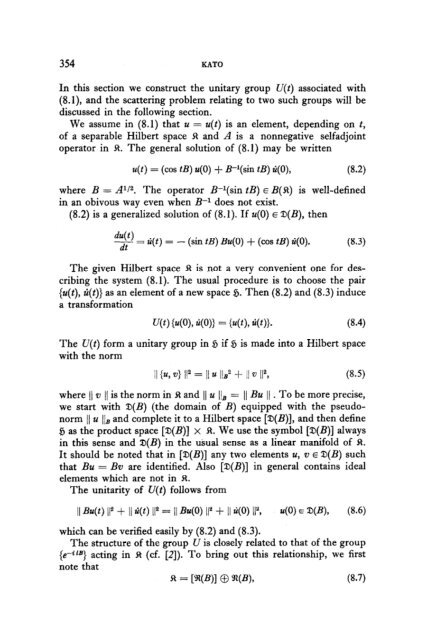On the Characters and the Plancherel Formula of Nilpotent Groups ...
On the Characters and the Plancherel Formula of Nilpotent Groups ...
On the Characters and the Plancherel Formula of Nilpotent Groups ...
You also want an ePaper? Increase the reach of your titles
YUMPU automatically turns print PDFs into web optimized ePapers that Google loves.
354 KATO<br />
In this section we construct <strong>the</strong> unitary group U(t) associated with<br />
(8.1), <strong>and</strong> <strong>the</strong> scattering problem relating to two such groups will be<br />
discussed in <strong>the</strong> following section.<br />
We assume in (8.1) that u = u(t) is an element, depending on t,<br />
<strong>of</strong> a separable Hilbert space R <strong>and</strong> A is a nonnegative selfadjoint<br />
operator in R. The general solution <strong>of</strong> (8.1) may be written<br />
u(t) = (cos tB) u(O) + B-‘(sin tB) C(O), (W<br />
where B = A1/2. The operator B-r(sin tB) E B(R) is well-defined<br />
in an obivous way even when B-l does not exist.<br />
(8.2) is a generalized solution <strong>of</strong> (8.1). If u(0) E D(B), <strong>the</strong>n<br />
du(t)<br />
- = C(t) = - (sin tl3) Bu(0) + (cos tB) C(O).<br />
dt<br />
(8.3)<br />
The given Hilbert space R is not a very convenient one for des-<br />
cribing <strong>the</strong> system (8.1). The usual procedure is to choose <strong>the</strong> pair<br />
(u(t), G(t)} as an element <strong>of</strong> a new space 8. Then (8.2) <strong>and</strong> (8.3) induce<br />
a transformation<br />
U(t) MO), 40)) = w>, W)). (8.4)<br />
The U(t) form a unitary group in $ if 5 is made into a Hilbert space<br />
with <strong>the</strong> norm<br />
II @, 4 II2 = II 21 lle2 + II u II23 (8.5)<br />
where 11 v I\ is <strong>the</strong> norm in R <strong>and</strong> 11 u IjB = II Bu 1) . To be more precise,<br />
we start with D(B) (<strong>the</strong> domain <strong>of</strong> B) equipped with <strong>the</strong> pseudonorm<br />
11 u IjB <strong>and</strong> complete it to a Hilbert space [D(B)], <strong>and</strong> <strong>the</strong>n define<br />
8 as <strong>the</strong> product space [a(B)] x R. We use <strong>the</strong> symbol [D(B)] always<br />
in this sense <strong>and</strong> D(B) in <strong>the</strong> usual sense as a linear manifold <strong>of</strong> R.<br />
It should be noted that in [D(B)] any two elements U, w E D(B) such<br />
that Bu = Bo are identified. Also [a(B)] in general contains ideal<br />
elements which are not in R.<br />
The unitarity <strong>of</strong> U(t) follows from<br />
II BW II2 + II WI II2 = II wx II2 + II YO) II29 +-4 E qa W)<br />
which can be verified easily by (8.2) <strong>and</strong> (8.3).<br />
The structure <strong>of</strong> <strong>the</strong> group U is closely related to that <strong>of</strong> <strong>the</strong> group<br />
{e-f1B} acting in R (cf. [2]). To bring out this relationship, we first<br />
note that<br />
Jt = p(B)] 0 W(B), 63.7)

















